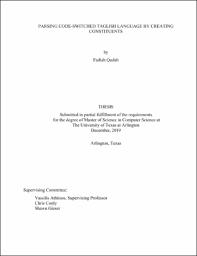
ATTENTION: The works hosted here are being migrated to a new repository that will consolidate resources, improve discoverability, and better show UTA's research impact on the global community. We will update authors as the migration progresses. Please see MavMatrix for more information.
Show simple item record
| dc.contributor.advisor | Athitsos, Vassilis | |
| dc.creator | Qudah, Fadiah | |
| dc.date.accessioned | 2020-01-10T21:56:48Z | |
| dc.date.available | 2020-01-10T21:56:48Z | |
| dc.date.created | 2019-12 | |
| dc.date.issued | 2019-12-10 | |
| dc.date.submitted | December 2019 | |
| dc.identifier.uri | http://hdl.handle.net/10106/28861 | |
| dc.description.abstract | When extracting meaning from language, a common first step is to break down language into constituents, or words that work together as a unit. This task, known as parsing, typically follows a specific grammar in order decompose the language into its underlying structure composed of constituents. Difficulties with this grammar-based parsing occur, however, with real-world natural language due to its unstructured nature. Code-switching, the phenomenon of alternating between languages while communicating, further complicates this task by requiring us to parse based on two (or more) languages instead of one. In this thesis, a data-driven method to parse code-switched language into its constituents is presented. The code- switched language used in this thesis is Taglish, comprised of English and Tagalog, and the data is collected from the social media site Twitter. | |
| dc.format.mimetype | application/pdf | |
| dc.language.iso | en_US | |
| dc.subject | Language | |
| dc.title | PARSING CODE-SWITCHED TAGLISH LANGUAGE BY CREATING CONSTITUENTS | |
| dc.type | Thesis | |
| dc.degree.department | Computer Science and Engineering | |
| dc.degree.name | Master of Science in Computer Science | |
| dc.date.updated | 2020-01-10T21:58:58Z | |
| thesis.degree.department | Computer Science and Engineering | |
| thesis.degree.grantor | The University of Texas at Arlington | |
| thesis.degree.level | Masters | |
| thesis.degree.name | Master of Science in Computer Science | |
| dc.type.material | text | |
| dc.creator.orcid | 0000-0002-3346-3795 | |
Files in this item
- Name:
- QUDAH-THESIS-2019.pdf
- Size:
- 954.8Kb
- Format:
- PDF
This item appears in the following Collection(s)
Show simple item record


